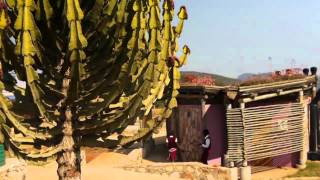-
1 / 19
Project update July 2013 – School infrastructure from local resources, Vryheid, South Africa
Green roofs using hardy indigenous plants preserve biodiversity, provide insulation and aesthetics, and also assist in the management of stormwater runoff. Photo: East Coast Architects.
Vele Secondary School recently was announced the joint winner of the Afrisam-South African Institute of Architects (SAIA) Award for Sustainable Architecture, and was highly commended by the jury for rejuvenating the planet while uplifting people. The Vele Secondary School has been transformed from a dilapidated rural school into a pioneering community resource.
Last updated: July 15, 2013 Vryheid, South Africa
Design features of the school include rainwater harvesting with a capacity of 150,000L and 50m2 of solar panels that provide sufficient power for 80 computers. The passive and low-energy design also creates naturally-lit and ventilated classrooms. The use of local resources as building materials and local stone masons reduces the carbon footprint of the structure, and invests in the local economy.
Project wins 2010 Award for Excellence from the South African Institute of Architects
In 2010, only three buildings received Awards for Excellence which are bestowed by the South African Institute of Architects (SAIA) for exceptional designs every two years. The Seven Fountains Primary School in the KwaZulu-Natal Province of South Africa was one of the three projects honored with this award.
 The project was commended by the SAIA for moving away from the one-size-fits-all practice of parachuting blueprint-based structures into rural areas, and allowing for the architecturally-guided emergence of a school organically connected to the community that built it and which it serves. The choice of materials for the site was informed by a skills and materials audit conducted at an early stage within the township. The jury citation noted that “sustainability on a holistic, social, economic and ecological level was well exhibited in this delightful project”.
The project was commended by the SAIA for moving away from the one-size-fits-all practice of parachuting blueprint-based structures into rural areas, and allowing for the architecturally-guided emergence of a school organically connected to the community that built it and which it serves. The choice of materials for the site was informed by a skills and materials audit conducted at an early stage within the township. The jury citation noted that “sustainability on a holistic, social, economic and ecological level was well exhibited in this delightful project”.
Schools network construction
Lakeside Primary School also in KwaZulu-Natal Province was due to start construction by the end of 2010. Vele High School in a deep rural, mountainous region of the Limpopo Province of South Africa was completed in January 2011 and includes:
- Extensive community engagement with learners, educators and local residents, including photographic and mapping workshops with learners and skills and materials audits with local residents.
- Rainwater harvesting installation with a total storage capacity of 150,000 liters.
- 50m2 of solar photovoltaics which will provide electricity for 80 computers.
- Energy measuring and monitoring system to increase energy awareness and reduce energy costs. Results also inform the Creating Schools design program.
- Labor-intensive construction techniques using local materials and skills.
- Passive and low-energy design creating naturally lit and ventilated classrooms that are warm in winter and cool in summer.
- Green roofs provide insulation and wildlife habitat.
- Campus layout designed to facilitate shared use of school facilities by local community and surrounding schools.
- Food gardens to supplement the school nutrition program.
- Explicit design and construction features integrated into the school curriculum.

